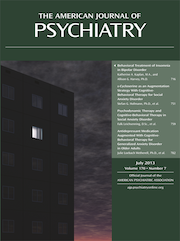T
o the E
ditor: Major depression is a common neuropsychiatric disorder involving genetic components. A recent genome-wide association study identified a risk single-nucleotide polymorphism (SNP), rs1545843 in
SLC6A15 (
1), which encodes a sodium-dependent branched-chain amino acid transporter. The risk SNP also revealed associations with alterations in hippocampal volume, neuronal integrity, and
SLC6A15 expression (
1), but it remains unclear how rs1545843 affects brain development, causing deficits in a specific brain region and eventually leading to susceptibility to major depression.
An informative way of dissecting the functional role of the risk SNP is to test its associations with brain structures using in vivo MRI methods. We recruited 278 unrelated healthy Han Chinese individuals without alcohol dependence, mental disorders, drug abuse, or brain injury. Structural images were acquired using a 3-T Philips MRI scanner, and a voxel-based morphometry method was used to provide voxel-wise assessment of volumetric difference. Detailed information about the sample, MRI acquisition, image preprocessing, and genotyping methods are provided in the
data supplement that accompanies the online edition of this letter. The effect of the genotype was examined using a linear regression at each voxel, adjusting for age, gender, and intracranial volume. Voxel-wise p values were corrected over the brain to control family-wise error rate.
We observed brain-wide significant association of rs1545843 with local gray matter volume in the median cingulate gyrus (family-wise error-corrected, voxel-wise p=0.031, cluster-wise p=0.0071,
Figure 1). The cingulate cortex is a structurally heterogeneous brain region mainly involved in emotion and cognition processes (
2), and deficits in patients with major depression have been frequently reported in this brain region. In addition, smaller regional gray matter volume of the cingulate gyrus has been observed in patients with major depression (
3), although this has been more frequently reported in the anterior cingulate gyrus, while the median cingulate gyrus was rarely studied and the biological effects of this region on major depression are still unclear. However, we did not find a significant association in the hippocampus as described by Kohli et al. (
1), and the discrepancy is possibly a result of sample difference. Patients with major depression and healthy comparison subjects were both evaluated in the Kohli et al. study, while we assessed only healthy individuals.
In summary, our results provide evidence for a potential role of rs1545843 in the brain, implying a possible pathophysiological mechanism underlying susceptibility to major depression, and further studies are warranted.


